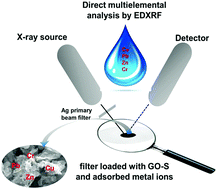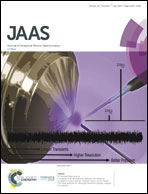Energy dispersive X-ray fluorescence spectrometric determination of copper, zinc, lead and chromium species after preconcentration on graphene oxide chemically modified with mercapto-groups†
Abstract
A novel derivative of graphene oxide, referred to as GO-S, was used as an effective adsorbent for the preconcentration of heavy metal ions from water samples and chromium for chemical speciation prior to energy dispersive X-ray fluorescence spectrometric (EDXRF) determination. Under optimal conditions GO-S quantitatively adsorbs Cr(III), Cu(II) Zn(II) and Pb(II) ions from aqueous samples. The determined adsorption capacity of GO-S for Cr(III), Cu(II), Zn(II) and Pb(II) ions is 191.5, 410.7, 265.6, and 487.3 mg g−1, respectively. The experimental data are fitted well to the Langmuir isotherm model which indicates that the adsorption has a chemical character. The utility of GO-S as a solid adsorbent was confirmed by developing a procedure based on a combination of dispersive micro-solid phase extraction (DMSPE) with EDXRF. Such a strategy allows direct determination of metal ions preconcentrated on the GO-S surface and consequently the elution step with all its drawbacks such as time, efficiency and contamination risk can be omitted. The linear response for the method was obtained in the 1–200 ng mL−1 range for each of the examined metal ions. The uncertainty of the proposed procedure did not exceed 3.8%. The detection limits are found to be in the 0.06–0.10 ng mL−1 range and they are much lower than the upper concentration limits for Cr(III), Cu(II), Zn(II) and Pb(II) in drinking water established by the World Health Organization. This method offers impressive enrichment factors ranging between 520 and 3120 for 50 mL-in-volume samples and it is resistant to high concentration of a large number of anions and alkali and alkaline earth cations. The application of the described procedure to the determination of Cr(III), Cu(II), Zn(II) and Pb(II) ions in lake, river, spring, mineral and sea waters confirms the usefulness of GO-S as a solid adsorbent. Moreover, the preconcentration of chromium for chemical speciation and EDXRF determination using GO-S is also possible due to the fact that the carrier selectively retains Cr(III) on its surface while Cr(VI) ions remain in the aqueous sample. The Cr(VI) concentration is calculated as the difference between the total chromium content (after reduction of Cr(VI) to Cr(III)) and the Cr(III) content.

- This article is part of the themed collection: JAAS Recent HOT articles


 Please wait while we load your content...
Please wait while we load your content...